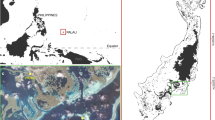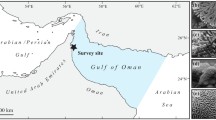Abstract
Despite the global accumulation of coral spawning records over the past three decades, information on inter-annual variation in spawning time is still insufficient, resulting in difficulty in predicting coral spawning time. Here, we present new information on in situ spawning times of scleractinian corals at Lyudao, Taiwan, covering their inter-annual variations over a 7-yr period (2010–2016). Spawning of 42 species from 16 genera in eight families was recorded. The majority were hermaphroditic spawners (38 of 42 species), and their spawning occurred 2–4 h after sunset on 1–11 d after the full moon (AFM), mostly in April and May. There were two distinct patterns in the two dominant taxa, the genus Acropora (14 species) and the family Merulinidae (18 species in eight genera). The annual spawning of Acropora corals mostly occurred on a single night in May with high inter-annual variation of spawning (lunar) days between 1 and 11 d AFM. In contrast, the annual spawning of merulinid corals commonly occurred over 2–3 consecutive nights in two consecutive months, April and May, with the specific range of spawning days around the last quarter moon (between 5 and 8 d AFM). The distinct spawning patterns of these taxa were also documented at Okinawa and Kochi, Japan, where similar long-term monitoring of in situ coral spawning has been conducted. This variability in spawning days implies different regulatory mechanisms of synchronous spawning where Acropora corals might be more sensitive to exogenous environmental factors (hourglass mechanism), compared to merulinid corals, which may rely more on endogenous biological rhythms (oscillator mechanism).





Similar content being viewed by others
References
Ananthasubramaniam B, Nisbet RM, Morse DE, Doyle FJ (2010) Integrate-and-fire models of insolation-driven entrainment of broadcast spawning in corals. Theor Ecol 4:69–85
Babcock RC, Willis BL, Simpson CJ (1994) Mass spawning of corals on a high latitude coral reef. Coral Reefs 13:161–169
Babcock RC, Bull GD, Harrison PL, Heyward AJ, Oliver JK, Wallace CC, Willis BL (1986) Synchronous spawnings of 105 scleractinian coral species on the Great Barrier Reef. Mar Biol 90:379–394
Baird AH, Guest JR, Willis BL (2009) Systematic and biogeographical patterns in the reproductive biology of scleractinian corals. Annu Rev Ecol Evol Syst 40:551–571
Bouwmeester J, Berumen ML, Baird AH (2011) Daytime broadcast spawning of Pocillopora verrucosa on coral reefs of the central Red Sea. Galaxea 13:23–24
Bouwmeester J, Baird AH, Chen CJ, Guest JR, Vicentuan KC, Berumen ML (2015) Multi-species spawning synchrony within scleractinian coral assemblages in the Red Sea. Coral Reefs 34:65–77
Brady AK, Hilton JD, Vize PD (2009) Coral spawn timing is a direct response to solar light cycles and is not an entrained circadian response. Coral Reefs 28:677–680
Budd AF, Fukami H, Smith ND, Knowlton N (2012) Taxonomic classification of the reef coral family Mussidae (Cnidaria: Anthozoa: Scleractinia). Zool J Linn Soc 166:465–529
Chamberland VF, Snowden S, Marhaver KL, Petersen D, Vermeij MJ (2017) The reproductive biology and early life ecology of a common Caribbean brain coral, Diploria labyrinthiformis (Scleractinia: Faviinae). Coral Reefs 36:83–94
Dai CF, Horng S (2009) Scleractinia fauna of Taiwan I. The complex group. National Taiwan University, Taipei
Dai CF, Soong K, Fan TY (1992) Sexual reproduction of corals in northern and southern Taiwan. Proc 7th Int Coral Reef Symp 1:448–455
Fogarty ND, Vollmer SV, Levitan DR (2012) Weak prezygotic isolating mechanisms in threatened Caribbean Acropora corals. PLoS ONE 7:e30486
Fukami H, Chen CA, Budd AF, Collins A, Wallace C, Chuang YY, Chen C, Dai CF, Iwao K, Sheppard C, Knowlton N (2008) Mitochondrial and nuclear genes suggest that stony corals are monophyletic but most families of stony corals are not (Order Scleractinia, Class Anthozoa, Phylum Cnidaria). PLoS ONE 3:e3222
Gorbunov MY, Falkowski PG (2002) Photoreceptors in the cnidarian hosts allow symbiotic corals to sense blue moonlight. Limnol Oceanogr 47:309–315
Harrison PL (2011) Sexual reproduction of scleractinian corals. In: Dubinsky Z, Stambler N (eds) Coral reefs: an ecosystem in transition. Springer, Dordrecht, pp 59–85
Hayashibara T, Iwao K, Omori M (2004) Induction and control of spawning in Okinawan staghorn corals. Coral Reefs 23:406–409
Hayashibara T, Shimoike K, Kimura T, Hosaka S, Heyward A, Harrison P, Kudo K, Omori M (1993) Patterns of coral spawning at Akajima Island, Okinawa, Japan. Mar Ecol Prog Ser 101:253–262
Howells EJ, Abrego D, Vaughan GO, Burt JA (2014) Coral spawning in the Gulf of Oman and relationship to latitudinal variation in spawning season in the northwest Indian Ocean. Sci Rep 4:7484
Huang D, Benzoni F, Fukami H, Knowlton N, Smith ND, Budd AF (2014) Taxonomic classification of the reef coral families Merulinidae, Montastraeidae, and Diploastraeidae (Cnidaria: Anthozoa: Scleractinia). Zool J Linn Soc 171:277–355
Hunter CL (1988) Environmental cues controlling spawning in two Hawaiian corals, Montipora verrucosa and M. dilatata. Proc 6th Int Coral Reef Symp 2:727–732
Jokiel PL, Ito RY, Liu PM (1985) Night irradiance and synchronization of lunar release of planula larvae in the reef coral Pocillopora damicornis. Mar Biol 88:167–174
Kaniewska P, Alon S, Karako-Lampert S, Hoegh-Guldberg O, Levy O (2015) Signaling cascades and the importance of moonlight in coral broadcast mass spawning. Elife 4:e09991
Keith SA, Maynard JA, Edwards AJ, Guest JR, Bauman AG, van Hooidonk R, Heron SF, Berumen ML, Bouwmeester J, Piromvaragorn S, Rahbek C, Baird AH (2016) Coral mass spawning predicted by rapid seasonal rise in ocean temperature. Proc R Soc Lond B Biol Sci 283:20160011
Kojis BL, Quinn NJ (1981) Aspects of sexual reproduction and larval development in the shallow water hermatypic coral, Goniastrea australensis (Edwards and Haime, 1857). Bull Mar Sci 31:558–573
Levitan DR (1998) Sperm limitation, sperm competition and sexual selection in external fertilizers. In: Birkhead T, Moller A (eds) sperm competition and sexual selection. Academic Press, San Diego, pp 173–215
Levitan DR, Petersen C (1995) Sperm limitation in the sea. Trends Ecol Evol 10:228–231
Levitan DR, Fogarty ND, Jara J, Lotterhos KE, Knowlton N (2011) Genetic, spatial, and temporal components of precise spawning synchrony in reef building corals of the Montastraea annularis species complex. Evolution 65:1254–1270
Levy O, Appelbaum L, Leggat W, Gothlif Y, Hayward DC, Miller DJ, Hoegh-Guldberg O (2007) Light-responsive cryptochromes from a simple multicellular animal, the coral Acropora millepora. Science 318:467–470
Lin CH, Soong K, Fan TY (2013) Hourglass mechanism with temperature compensation in the diel periodicity of planulation of the coral, Seriatopora hystrix. PLoS ONE 8:e64584
Mendes JM, Woodley JD (2002) Timing of reproduction in Montastraea annularis: relationship to environmental variables. Mar Ecol Prog Ser 227:241–251
Mercier A, Hamel JF (2009) Endogenous and exogenous control of gametogenesis and spawning in echinoderms. Adv Mar Biol 55:1–302
Mercier A, Hamel JF (2010) Synchronized breeding events in sympatric marine invertebrates: role of behavior and fine temporal windows in maintaining reproductive isolation. Behav Ecol Sociobiol 64:1749–1765
Mezaki T, Hayashi T, Iwase F, Nakachi S, Nozawa Y, Miyamoto M, Tominaga M (2007) Spawning patterns of high latitude scleractinian corals from 2002 to 2006 at Nishidomari, Otsuki, Kochi, Japan. Kuroshio Biosphere 3:33–47
Miller MW, Williams DE, Fisch J (2016) Genet-specific spawning patterns in Acropora palmata. Coral Reefs 35:1393–1398
Nozawa Y (2012) Annual variation in the timing of coral spawning in a high-latitude environment: influence of temperature. Biol Bull 222:192–202
Paxton CW, Baria MVB, Weis VM, Harii S (2016) Effect of elevated temperature on fecundity and reproductive timing in the coral Acropora digitifera. Zygote 24:511–516
Penland L, Kloulechad J, Idip D, van Woesik R (2004) Coral spawning in the western Pacific Ocean is related to solar insolation: evidence of multiple spawning events in Palau. Coral Reefs 23:133–140
Simpson CJ (1985) Mass spawning of scleractinian corals in the Dampier archipelago and the implications of management of coral reefs in Western Australia. Aust Dep Conserv Environ Bull 244:1–35
van Woesik R (2009) Calm before the spawn: global coral spawning patterns are explained by regional wind fields. Proc R Soc Lond B Biol Sci 277:715–722
van Woesik R, Lacharmoise F, Köksal S (2006) Annual cycles of solar insolation predict spawning times of Caribbean corals. Ecol Lett 9:390–398
Veron JEN (1995) Corals in space and time: the biogeography and evolution of the Scleractinia. UNSW Press, Sydney
Veron JEN (2000) Corals of the world, vol 1–3. Australian Institute of Marine Science, Townsville
Wallace CC (1999) Staghorn corals of the world: a revision of the coral genus Acropora (Scleractinia; Astrocoeniina; Acroporidae) worldwide, with emphasis on morphology, phylogeny and biogeography. CSIRO Publishing, Collingwood
Acknowledgements
We thank current and previous members of our laboratory, especially A-C Chung, T-Y Huang, H-S Hsieh, C-H Liu, and M-C Chang for their field assistance and data collection. Chiu-Fu Diving Shop, Lyudao Marine Station, and S-L Chen provided invaluable field support. Comments from three anonymous reviewers greatly improved the manuscript. Aziz Mulla kindly edited English in the final manuscript. The study was funded by an internal research grant of Biodiversity Research Center, Academia Sinica to Y.N.
Author information
Authors and Affiliations
Corresponding author
Additional information
Communicated by Biology Editor Dr. Mark J. A. Vermeij
Electronic supplementary material
Below is the link to the electronic supplementary material.
Rights and permissions
About this article
Cite this article
Lin, CH., Nozawa, Y. Variability of spawning time (lunar day) in Acropora versus merulinid corals: a 7-yr record of in situ coral spawning in Taiwan. Coral Reefs 36, 1269–1278 (2017). https://doi.org/10.1007/s00338-017-1622-5
Received:
Accepted:
Published:
Issue Date:
DOI: https://doi.org/10.1007/s00338-017-1622-5




